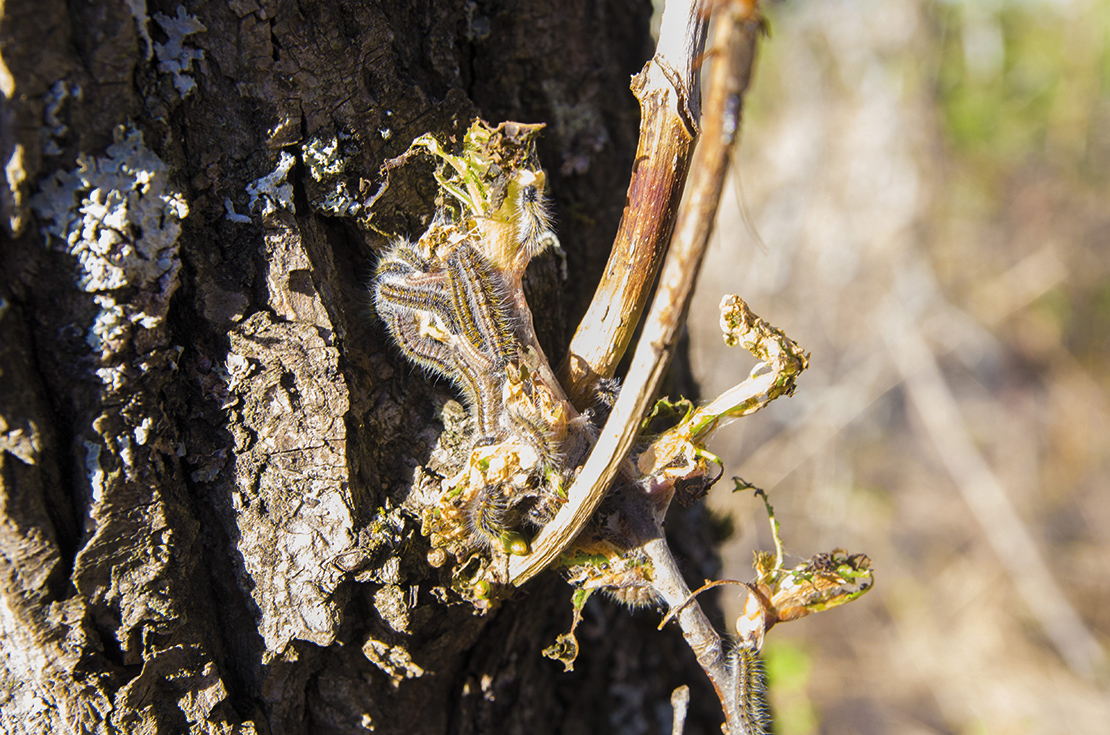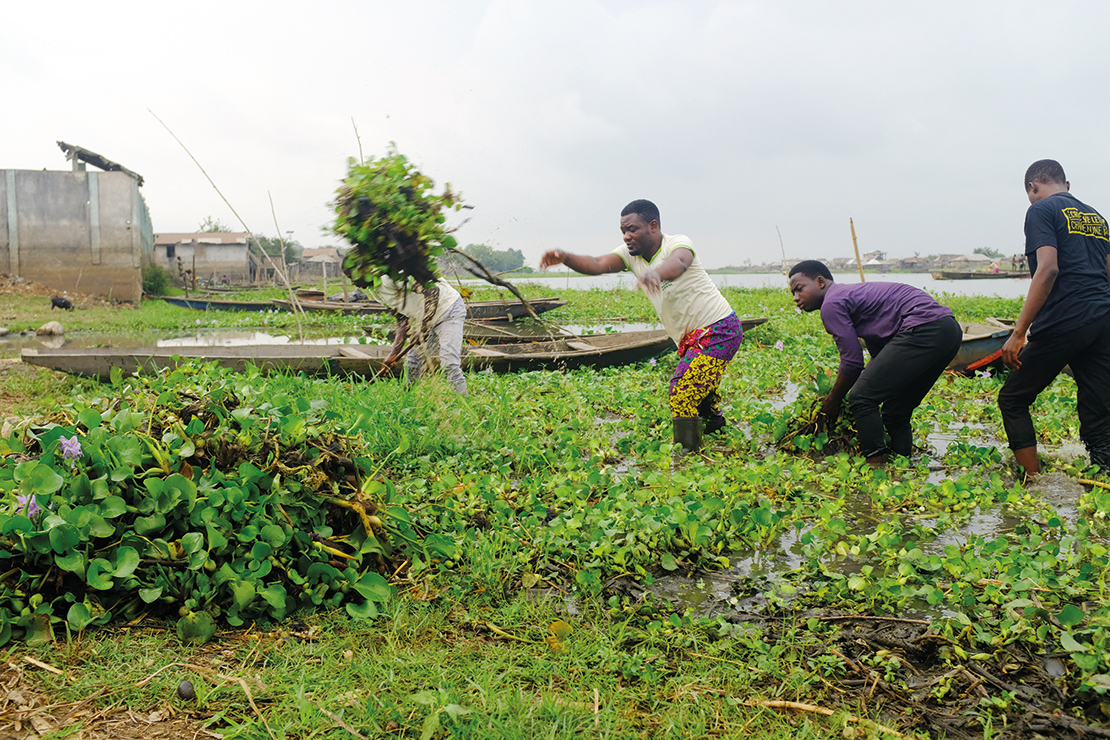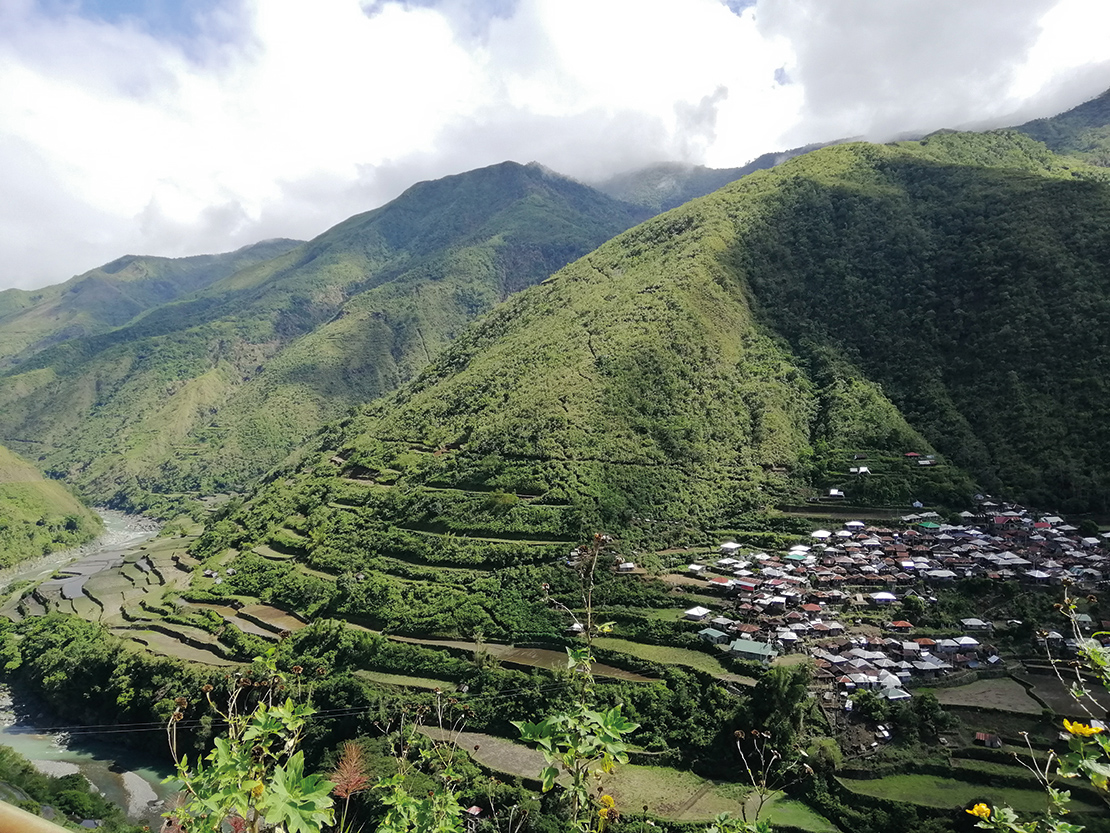
Target 9: Invasive alien species prevented and controlled
By 2020, invasive alien species and pathways are identified and prioritized, priority species are controlled or eradicated, and measures are in place to manage pathways to prevent their introduction and establishment.
Key messages
- IPLCs are taking proactive actions and initiatives to address the ever-growing serious threats and risks posed by invasive alien species to their cultural, economic, environmental, food and water systems.
- Effective partnerships between indigenous peoples and local communities (IPLCs) and other actors already exist at national levels, built on traditional knowledge and the actions of IPLCs to control, or use, invasive alien species; these partnerships have great potential for expansion.
- At the global level, IPLCs are actively promoting a holistic approach to reducing invasive alien species—identifying, assessing, monitoring, controlling and eradicating.
Significance of Target 9 for IPLCs
IPLCs can have differing approaches towards invasive alien species. IPLCs work to establish relations with all the species that make a home in their lands, waters and territories, and develop rules for interacting with, or protecting against, each species.1 However, many species classified by scientists as invasive alien species are also of urgent concern to IPLCs because of their severe impacts. These impacts are a major threat to the livelihoods of IPLCs because through their disruption of ecosystems they damage many of the resources that IPLCs need to sustain a good quality of life. These include resources that are critical for food, shelter, health, security, social and cultural activities, and economic opportunities.2
The global cost of managing invasive alien species is estimated at US$1.4 trillion per year— close to five per cent of global gross domestic product.3 IPLCs, because of their direct dependence on local natural resources for their livelihoods, carry distinct burdens in terms of the negative impacts of invasive alien species. For example:
- Across Africa, invasive species threaten agricultural systems and crop productivity. For example, the fall armyworm can cause maize yield losses of up to 17.7 million tonnes a year, equivalent to US$4.6 billion,4 which is likely to affect IPLCs severely.
- Invasive species can also affect IPLC cultures. For example, over the last 10 years the emerald ash borer has infected ash trees on the lands and territories of the Mohawk people of Kahnawa:ke in Canada. This has affected traditional basket-making and raised concern about the potential loss of knowledge about the trees, as their population declines.5
Contributions and experiences of IPLCs towards Target 9
IPLCs have first-hand knowledge of the impacts of invasive alien species on the biodiversity in their lands, as well as on their communities and their cultures. Many IPLCs are, therefore, working to learn more about these species and combat their effects.6 Because of their presence on the ground, IPLCs are often the first to detect the early warning signs, and are also well placed to monitor, manage and control them. In some countries they have begun to conduct risk assessments of invasive alien species, and to assess possible uses of newly arrived species. Examples of IPLC actions on the ground and involvement in relevant policy forums are highlighted below.
Community-based monitoring of invasive alien species
There are many examples where IPLCs play an important role in identifying and monitoring invasive alien species. For example:
- In Siberia and the Arctic, IPLCs have documented an increase in the appearance of ticks infected with tick-borne encephalitis virus and tick-borne borreliosis (Lyme disease).7 The spread of this ticks to the Arctic is associated with temperature increases in the northern territories.8
- The Guna people in Panama have developed a participatory map of lionfish sightings in their coastal marine waters. Lionfish is an invasive alien species that is extremely damaging to native fish species; it is also poisonous, posing a health risk to the Guna.9
- The Māori in Aotearoa/New Zealand have collaborated in the development of a culturally based methodological framework for monitoring kauri dieback, which is caused by a deadly fungus-like exotic species.10
Box 18: Polina Shulbaeva, Centre for Support of Indigenous Peoples of the North
Silk moth caterpillars cause significant damage to conifers. Credit: Pavel Komogorov.

Case study: Indigenous monitoring of silk moths in the Arctic and Siberia11
Indigenous monitoring has made it possible to document an increase in the distribution of alien species across the Arctic and Siberia. One such species is the silk moth—one of the most dangerous insect pests—which is currently moving northwards. Silkworms are difficult to find and indigenous people are playing a critical role by alerting officials to new sightings.
— Read the full case study
IPLC adaptations: finding new uses for invasive alien species
In some cases, IPLCs find uses for invasive alien species and adapt their livelihoods and cultural practices accordingly. Examples include the water hyacinth in Benin (see Box 19); the Kamchatka king crab on the Arctic coast of Russia and Norway,12 which has become part of the local diet; cattails in North America, which are used both for food and for heating, replacing wood;13 and feral domestic cats in Australia, which are managed by Aboriginal communities for food and economic gain.14 Harvesting invasive alien species for use can be an integrated part of control mechanisms, thereby helping to protect native species from the impacts of invasive alien species.15
Box 19: Patrice Sagbo, Actions pour le Développement Durable, Benin
Clearing water hyacinth from the lake. Credit: © Sébastien Roux/Reporterre.

Case study: Finding alternative uses for invasive species; the water hyacinth in Benin
Native to South America, the water hyacinth (Eichhornia crassipes) has caused problems for local lake communities and the environment across East Africa. In Benin, it makes travel by canoe difficult, and affects the livelihoods of local fishing communities. In recent years, local communities—especially women—have managed this invasive species by harvesting it for use as compost and crafts material.
— Read the full case study

Travelling by canoe—an important way for local communities to get around—is impeded by the rapid growth of water hyacinth. Credit: Beata Tabak.
Collaborating with governments and scientists to manage and control invasive alien species
Many IPLCs actively manage and control invasive alien species on their lands, either alone or in collaboration with scientists:
- IPLCs in different parts of the world use traditional controlled burning, which destroys invasive weed species, including seeds, and allows local fire-adapted species to regenerate and recover.
- In Queensland, Australia, indigenous rangers have been working with NGOs and government since 2014 to detect, monitor and control pond apple infestations in the Eastern Kuku Yalanji Indigenous Protected Area.16
- In Canada, invasive alien species are co-operatively managed by the Council of the Haida Nation and the Government of Canada over their land and sea; they have successfully eradicated the North American rat.17
- IPLCs are working with the Secretariat of the Pacific Regional Environment Programme to prevent, control and manage invasive alien species across the Pacific Islands, with support from the Global Environment Facility. Invasive alien species are the most important cause of extinction of endemic species in the region, and their management is a necessary cost of trade and transport between islands. A Pacific-wide strategy has been developed that includes resources to support learning, reporting, and education, as well as the management of invasive alien species across the islands.18
Collaborative approaches to management and control are particularly beneficial in that they can result in a more holistic approach to monitoring and management, and in the development of innovative approaches. They can also lead to improved mutual understanding and capacity-building.
In some cases, IPLCs have also taken measures to remove alien species that they had been encouraged to introduce, but which they later realised had harmed the environment. Box 20 details one such case from the Philippines.
Box 20: Venecio Lingbawan, Indigenous Farmers’ Association of Guinaang, Pasil and Florence Daguitan, Tebtebba Foundation
A gmelina tree. Credit: pisitpong2017.

Case study: Controlling the invasive gmelina tree and bringing back biodiversity in Kalinga, Philippines
In the 1990s, the gmelina tree (Gmelina arborea) was promoted by the government (Department of Environment and Natural Resources) in our territory in Guinaang Pasil, Kalinga. It is fast-growing, they said, and can be harvested for timber after 10 years.
— Read the full case study

A settlement and rice terraces in Kalinga province. Credit: Jazel Mae Caboteja
IPLC involvement in policy forums
IPLCs participate in global policy processes related to invasive alien species and are also active in national policy and implementation measures in several countries:
- In some countries, IPLCs are participating in the development of national inventories and monitoring systems for invasive alien species. For example, in Norway the Saami have been working alongside the government and NGOs to obtain country data on invasive alien species. The Norwegian Biodiversity Information Centre incorporates the traditional knowledge of the Saami people.
- In December 2019, IPLCs participated fully in a meeting of the UN CBD Ad Hoc Technical Expert Group on invasive alien species, which advanced work on advice and technical guidance for managing invasive alien species.
- The full and effective participation of IPLCs is expected in the invasive alien species assessment by the Intergovernmental Science-Policy Platform on Biodiversity and Ecosystem Services (IPBES), which will run between 2019 and 2023. The assessment will incorporate information on IPLC responses to invasive alien species and on their adaptation and management strategies.
- The IPBES has established a task force on indigenous and local knowledge; it is also recognising IPLCs who are able to contribute as authors, reviewers or participants in workshops and review processes, and who can be included as resources and sources of information. The benefits for IPLCs must be fair, equitable and realised in order to recognise and acknowledge their input. Free, prior and informed consent is also applied and central to the IPBES’s work with IPLCs.
- Despite the above, there is little recognition of the role of IPLCs within the framework of the Global Register of Introduced and Invasive Species19, which compiles information from more than 190 countries.
Opportunities and recommended actions
- IPLCs should continue actions and initiate programmes to manage invasive alien species within their territories, as part of local biodiversity strategies and action plans, applying traditional knowledge and community-based monitoring.
- IPLCs and their partners should build awareness of community-based monitoring and information systems (CBMIS) among governments and natural resource management professionals.
- Governments and relevant actors should increase financial, technical and other forms of support to upscale CBMIS of invasive alien species and for programmes to mitigate the impact of invasive species on IPLCs.
- Governments and relevant national and international agencies, in partnership with IPLCs, should develop and strengthen multiple evidence-based monitoring and response systems for invasive species, incorporating the traditional knowledge of indigenous peoples and including mechanisms for instant response where appropriate.
- Natural resource institutions, government departments, universities, research centres and NGOs should develop two-way transferrable skills programmes to foster capacity-building and mutual learning between IPLCs and scientists.
Key resources
- Reo, N. J., Whyte, K., Ranco, D., Brandt, J., Blackmer, E., Elliott, B. (2017) ‘Invasive species, indigenous stewards, and vulnerability discourse’, The American Indian Quarterly 41(3).
- Ens, E., Fisher, J. and Costello, O. (Editors) (2015) Indigenous people and invasive species: Perceptions, management, challenges and uses. IUCN Commission on Ecosystem Management Community Report. Available at: https://ipm.ifas.ufl.edu/pdfs/ens_et_al_2015_indigenous_people_and_invasive_species_iucn_cem_ecosystems_and_invasiv.pdf
- Centre for Agriculture and Bioscience International. ‘Impacts: Discover the economic, social and environmental impacts of invasive species’. Available at: https://www.invasive-species.org/impacts/
References
- Various (Unpublished) ‘Report of the Indigenous and local knowledge dialogue workshop for the IPBES thematic assessment of invasive alien species and their control’. 15–16 November 2019.
- Centre for Agriculture and Bioscience International (n.d) Impacts: Discover the economic, social and environmental impacts of invasive species. Centre for Agriculture and Bioscience International. Available at: https://www.invasive-species.org/impacts/.
—
Ens, E., Fisher, J. and Costello, O. (Editors) (2015) Indigenous people and invasive species: Perceptions, management, challenges and uses. IUCN Commission on Ecosystem Management Community Report. Available at: https://ipm.ifas.ufl.edu/pdfs/ens_et_al_2015_indigenous_people_and_invasive_species_iucn_cem_ecosystems_and_invasiv.pdf - Stave, K., Yemer, G. G., Aynalem, S. (Editors) (2017) Social and ecological system dynamics: Characteristics, trends and integration in the Lake Tana Basin, Ethiopia. Springer International Publishing.
- Rwomushana, I., Bateman, M., Beale, T., Beseh, P., Cameron, K., Chiluba, M., Clottey, V., Davis, T., Day, R., Early, R., Godwin, J., González-Moreno, P., Kansiime, M., Kenis, M., Makale, F., Idah, M., Murphy, S., Nunda, W., Phiri, N. and Tambo, J. (2018). Fall armyworm: impacts and implications for Africa: Evidence Note Update, October 2018. Centre for Agricultural Bioscience International.
- Various (Unpublished) ‘Report of the Indigenous and local knowledge dialogue workshop for the IPBES thematic assessment of invasive alien species and their control’. 15–16 November 2019.
- Reo, N. J., Whyte, K., Ranco, D., Brandt, J., Blackmer, E. and Elliott, B. (2017) ‘Invasive species, indigenous stewards, and vulnerability discourse’, The American Indian Quarterly 41(3).
- Yasyukevich V.V., Rybina E.A., Yasyukevich N.V. and Rudkova A.A. (2016) ‘Assessment of the vulnerability of the health of the population of the Russian Federation in relation to certain infectious and vector-borne diseases in a regional aspect for the first half of the XXI century: Problems of environmental monitoring and modeling of ecosystems’. T. 27. No. 1. M.: IGKE.
- Tokarevich, N., Tronin, A., Gnativ, B., Revich, B., Blinova, O. and Evengard, B. (2017). ‘Impact of air temperature variation on the ixodid ticks habitat and tick-borne encephalitis incidence in the Russian Arctic: the case of the Komi Republic’. International Journal of Circumpolar Health, 76(1). Available at: https://doi.org/10.1080/22423982.2017.1298882
- Forest Peoples Programme, the International Indigenous Forum on Biodiversity and the Secretariat of the Convention on Biological Diversity (2016) Local Biodiversity Outlook: Indigenous peoples’ and local communities’ contributions to the implementation of the Strategic Plan for Biodiversity 2011-2020. A complement to the fourth edition of the Global Biodiversity Outlook. Moreton-in-Marsh, England. Available at: https://www.cbd.int/gbo/gbo4/publication/lbo-en.pdf
- Forest Peoples Programme, the International Indigenous Forum on Biodiversity and the Secretariat of the Convention on Biological Diversity (2016) Local Biodiversity Outlook: indigenous peoples’ and local communities’ contributions to the implementation of the Strategic Plan for Biodiversity 2011-2020. A complement to the fourth edition of the Global Biodiversity Outlook. Moreton-in-Marsh, England. Available at: https://www.cbd.int/gbo/gbo4/publication/lbo-en.pdf
- For further information on this case, see: Ministry of Natural Resources and Environment of the Russian Federation (n.d.) The statute on the Ministry of Natural Resources and Environment of the Russian Federation: General provisions. Available at: http://www.mnr.gov.ru/en/
- Jørgensen, L.L. (2013) ‘Invasive Alien Species Fact Sheet – Paralithodes camtschaticus’. Online Database of the European Network on Invasive Alien Species. NOBANIS. Available at: https://www.nobanis.org/globalassets/speciesinfo/p/paralithodes-camtschatica/paralithodes_camtschaticus.pdf
- Bansal, S., Lishawa, S. C., Windham-Myers, L. (2019) ‘Typha (Cattail) invasion in North American wetlands: Biology, regional problems, impacts, ecosystem services, and management’. Wetlands (39).
—
Small, E. (2013) North American Cornucopia: Top 100 Indigenous Food Plants. Boca Raton: CRC Press. - Wahlquist, C. (2015) ‘Traditional hunters and western science join forces in the fight against feral cats’. The Guardian. Available at: https://www.theguardian.com/australia-news/2015/oct/27/traditional-hunters-and-western-science-join-forces-in-the-fight-against-feral-cats.
- Hose, N. and Deacon, B. (2018) ‘Could Aboriginal cat-hunting be the key to saving the bilby?’ Australian Broadcasting Corporation. Available at: https://www.abc.net.au/news/2018-09-16/feral-cat-hunting-in-kiwirrkurra-wa-to-protect-endangered-bilby/10241554.
- Forest Peoples Programme, the International Indigenous Forum on Biodiversity and the Secretariat of the Convention on Biological Diversity (2016) Local Biodiversity Outlook: Indigenous Peoples’ and local communities’ contributions to the implementation of the Strategic Plan for Biodiversity 2011-2020. A complement to the fourth edition of the Global Biodiversity Outlook. Moreton-in-Marsh, England. Available at: https://www.cbd.int/gbo/gbo4/publication/lbo-en.pdf
- Bellis, K.X.T., Peel, R.T., Irvine, R.L., Howald, G., and Alsop, G.J. (2019) ‘Beyond biodiversity: the cultural context of invasive species initiatives in Gwaii Haanas’. In Veitch, C.R., Clout, M.N., Martin, A.R., Russell, J.C. and West, C.J. (Eds) Island invasives: scaling up to meet the challenge. Occasional Paper SSC no. 62. Gland: IUCN.
- Secretariat of the Pacific Regional Environment Programme (2016) Battling Invasive Species in the Pacific: Outcomes of the Regional GEF-PAS IAS Project – Prevention, control and management of invasive species in the Pacific islands. Apia: Secretariat of the Pacific Regional Environment Programme. Available at: https://www.sprep.org/attachments/Publications/BEM/battling-invasive-species-pacific.pdf
- Global Register of Introduced and Invasive Species (n.d.) About GRIIS. Global Register of Introduced and Invasive Species. Available at: http://www.griis.org/about.php


